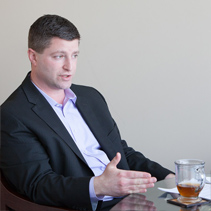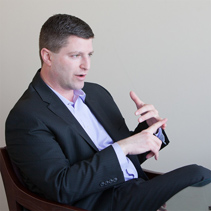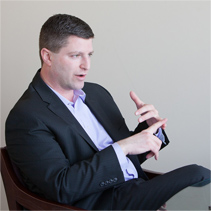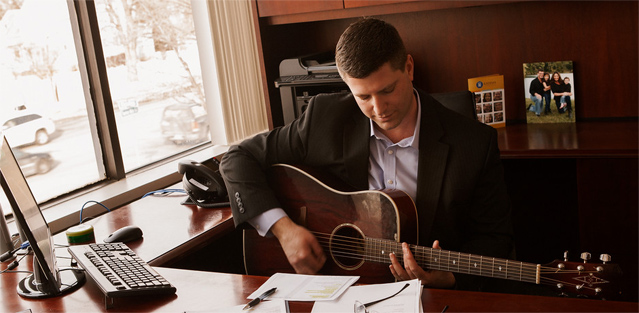Those with a Jewish soul and a smattering of Hebrew might recognize the word kadima, meaning forward. And forward is the word that resonates most often in conversation with Eric Adelman, speaking on behalf of the clients of the Jewish mental health agency, Kadima.
Moving forward, into his second year as Executive Director of Kadima, Eric already has navigated some of the challenges in the changing landscape of health care today. “It’s been a wonderful time of transition,” he says, “. . . to step into the role of a longtime director (Janette Shallal) who had been here for 21 years and built Kadima from one home about to lose its license to what we are today, serving more than 200 individuals and their families, based in 25 residential settings throughout Oakland County, as well as in therapy and group activities at the Zussman Activity Center in Southfield.”
The guitar in Eric’s office speaks to his youthful energy and a management style he describes as “hamish” (warm and welcoming). “There are days here that I feel like I’m Norm from Cheers. I walk into the Zussman Activity Center, steps from my office, and our clients welcome me so warmly. I think they’re truly happy to see someone like me who cares about them. Whether we’re talking about a tough issue or just schmoozing about last night’s football game, I feel we have a real connection.”
Listed among Crain’s 2014 “Class of 40 Under 40” honoring the community’s highest achievers, Eric has made a career of community work. Before coming to Kadima, he led a membership boom as Regional Director of BBYO Michigan Region – doubling the number of teens involved and tripling fundraising revenue – making it the second largest BBYO in the nation in terms community engagement. Prior to his tenure at BBYO, Eric held positions in development at JARC and in interfaith and government relations at the Jewish Community Relations Council.
Proud parents of daughters, Jocelyn (8) and Natalie (3), Eric and his wife, Karen, live in Farmington Hills, Michigan.
On family background and early influences
myJewishDetroit: Tell us about your family background. Your education. What drew you to Jewish communal work?
Eric: I grew up in Oak Park, went to Berkley High School and Beth Shalom Synagogue, spent seven summers at Tamarack Camps and was very involved in BBYO. (No surprises there.) As a kid, I always figured I’d be a doctor. But, I went off to college at George Washington University in D.C., took a chemistry course – and that ended my career in medicine! Instead, I spent my junior year at Hebrew Union College in Jerusalem and graduated with a Bachelor’s in Judaic Studies.
I considered being a rabbi. But, after graduation, I got my first job with BBYO in Milwaukee. I met my wife, Karen, through BBYO at a staff conference. She was working in Southern Florida, and we dated long distance for a year, then moved to Detroit in 2002 when an opportunity opened up at the Jewish Community Council (now Jewish Community Relations Council – JCRC).
Even though I didn’t have a clear career path from the start, being involved in the Jewish community always has been important to me.
In fact, for me, it started with the financial aid my parents received to send me to Tamarack. I was in third grade when my parents sat me down and said to me, “The only reason that you are going to camp is because members of this community have given. And when you’re older, it’s your responsibility to give back as well.” That conversation clearly has stuck with me. I was eight years old at the time. So I’d say it was good parenting that had a lot to do with my choices.
On Kadima
What do you see as Kadima’s biggest challenge?
Our immediate concern, of course, is the day-to-day care and well-being of the most vulnerable members of our community, people with chronic, persistent and, in some cases, debilitating mental illnesses. Illnesses – such as schizophrenia, bipolar disorder and pervasive depression – can further be complicated by co-substance abuse disorders, age-related illness and a host of other factors that come with living. Answering our clients’ needs comes first, and those needs always are changing.
Our long-term challenge is to make sure that Kadima is positioned strategically to continue to provide its vital services in a time when the healthcare landscape is shifting more rapidly than everyone can keep up with.
As we look to the future of mental health delivery, I envision that there will be a greater integration between physical and behavioral health. Moving forward, we’re going to have to be nimble and resourceful and well prepared to adapt to change.
What have been some of your first lessons on the job?
I’ll never forget my very first day on the job here. I had a ten o’clock meeting with one of our funders through the public system. Literally, it was my first meeting on my first day — and we were informed of a $36,000 cut in funding that virtually eliminated our transportation budget. So what I’ve learned from day one at Kadima is that our mental health system is very fragile, that the resources are not there in the way they need to be, that we must be pro-active in solving problems and vigilant in finding partners in the community.
The bulk of Kadima’s work is currently with adults. How do you see that model changing?
No question, we’ll see an increased demand for capacity in the near future. We are seeing more referrals now than in the past number of years and the occupancy rate in our homes has gone up steadily.
As for children’s services, we need a further assessment to determine what other agencies are involved in the delivery of services and in what ways it makes sense for us to step in. We are now in the process of strategic planning – examining the healthcare landscape of the community, the needs of our clients and the range of our services from top to bottom.
On the stigma of mental illness
Let’s talk about attitudes. There continues to be a stigma that exists around people with mental illness. Why do you think it’s so?
Unlike a physical illness or mental disability, mental illness can be difficult to understand. It is harder to see, often difficult to diagnose and certainly easier to mask than a physical illness, such as diabetes or cancer. And, in children, it’s not like a physical illness or a developmental disability that you can recognize early on and that everybody understands what care is going to be needed and what abilities a child will have.
And let’s be candid. There’s fear. Untreated mental illness can be scary. So often people see it for the first time in a roommate in college, in a son, in a nephew, somebody on your sports team – and when you see something happening that you can’t exactly comprehend, it can be very scary.
Certainly, there’s a greater role for Kadima moving forward in educating the community so that people understand that mental illness is common, chronic and treatable. It affects people of all ages, religions and socioeconomic backgrounds. And, most importantly, there are community resources available where people can get the help they need. People just need to speak up. Be aware. And share their experiences.
How do you envision Kadima growing its role in the community?
We have two initiatives in development. We’ve just started a new and comprehensive volunteer program with our first training session held a few weeks ago. We’re actively recruiting folks to share their skills and special interests with our clients and even in these early stages of the program, we’re getting great feedback from the community. The second program is a partnership with Jewish Family Service to train our staff as mental health first aid workers. Just as many of us take first aid training to learn what to do when a person is having a heart attack — so, too, do we need to provide those same skills in recognizing the signs of brain illnesses such as depression, anxiety, bipolar disorder, schizophrenia or addiction.
Again, we can’t emphasize enough the importance of education and advocacy as our best means to breaking down the stigma of mental illness.
On balancing family and professional life
How do you balance the demands of your work with your family life?
In our work here at Kadima, we strive for balance. Our workdays can be stressful, but to stay on top of our jobs we have to honor our personal lives, too. Though the demands of the agency and the population we serve are intense, I’m also a husband and a father of two young daughters and those lives take priority in my life.
I think it’s important for everyone – and perhaps for Jewish communal professionals in particular — to understand that we do good and important work. But there has to be a balance. I can do a better job here for our clients if I’m also being the husband and father that I need to be.
Balance also means you find time to do things you love. For me it’s music. I’m a self-taught guitar player, learning piano, drums, harmonica and sax. I started on the clarinet in grade school, so you could say I’m kind of a one-man band.
I’m also a wannabe foodie. Love to cook. My favorite thing in the world to cook is chicken stock. There’s something magical – alchemical (if that’s even a word) – when you take chicken parts, vegetables, water, heat and time and you get this golden elixir when you’re done.
On community leadership
What is your definition of a leader?
I believe a leader is a person with vision. I use the word change-agent, someone who understands the process of change in a positive way. A leader understands people’s perspectives – knows where they are coming from to craft a well thought path forward. A leader is someone capable of building teams who can share his or her vision and persevere in building consensus in moving an organization forward.
On returning to Detroit
An “import to Detroit,” my wife, Karen, was born in Montreal, grew up in southern Florida; her mother is Russian and her father is Israeli, so we both have had a strong Jewish upbringing. When I took the job with Council, our plan was to be here for two, three years max, then move back to Florida. And here we are, 13 years later with no plans to move.
For me, coming back to Detroit was coming home. For Karen, it’s taken a little while, but we’ve built a wonderful life here and she get’s got the “Detroit thing” now, proud to say she’s a Detroiter.
What changes have you seen in Jewish Detroit over recent years?
When I started my tenure with BBYO, Detroit was never one of the answers any teen would give when asked where they wanted to live after college graduation. As we’ve seen, there’s been a fundamental change in that attitude. Young people want to come back and stay. Credit where it’s due, I think Scott Kaufman and the Federation leadership have helped to make a difference in the way that the Jewish community views the future of Detroit. That’s not the only factor, of course. I think people finally get that Detroit is still a city for inventors and creators, a place where people can make a real difference.
At the time when Karen and I moved back, living in the city was not a realistic option. But if we were just starting out in our 20’s today, we’d move into the city in a heartbeat.
Favorites
Restaurants: Green Dot Stables, in Detroit. And a remote little bar called Mary Donnelly’s Public House in Keego Harbor. Best burgers in town! (I shouldn’t share this one because I don’t want to fight the crowds going there.)
Places to meet for coffee or drinks: Preferably not a Starbucks. Toasted Oak in Novi. And the Farmington Hills Library, quiet, comfortable, off the beaten path. And for a beer, I’m a fan of dive bars, any place you can saddle up to the bar and have a cheap bottle of beer is okay by me.
Building in the Detroit skyline: Love the view coming down Northwestern over that little crest where you can see all the way down toithe RenCen from Farmington Hills. To me, it’s a reminder that we’re still close and part of the downtown community.
Place to take kids/ visitors: Eastern Market. Kensington Metro Park. Hitsville, Motown Museum. And the scenic city tours on the People Mover. . . it’s a great and inexpensive way to spend some time with the kids.
Michigan vacations: Anywhere on Lake Michigan
Favorite places in Israel: Marzipan Bakery in Jerusalem. Mitzpe Ramon in the Negev desert.
Sports: Football.
Jewish food: Hamentashen. Gribenes (crackling-crisp renderings from chicken skin).
Jewish expression: Nu?! With the accent and the intonation. Frankly, almost any Jewish expression is my favorite as long as you say it the right way.
Guilty pleasures: A chocolate éclair from the Donut Cutter in Berkley. Staying up far later than I should playing guitar.
Never leave home without: Guitar pick. And Band-Aids because I’m a clutz.
Reading now
American Icon: Alan Mulally and the Fight to Save Ford Motor Company, by Bryce G. Hoffman
(But most of the time, my reading consists of PJ Library books at my kids’ bedtimes!)








